It’s been a while since I posted any ancestral info on this blog but here’s another branch of my family who kept pubs in Hebden Bridge and Heptonstall.
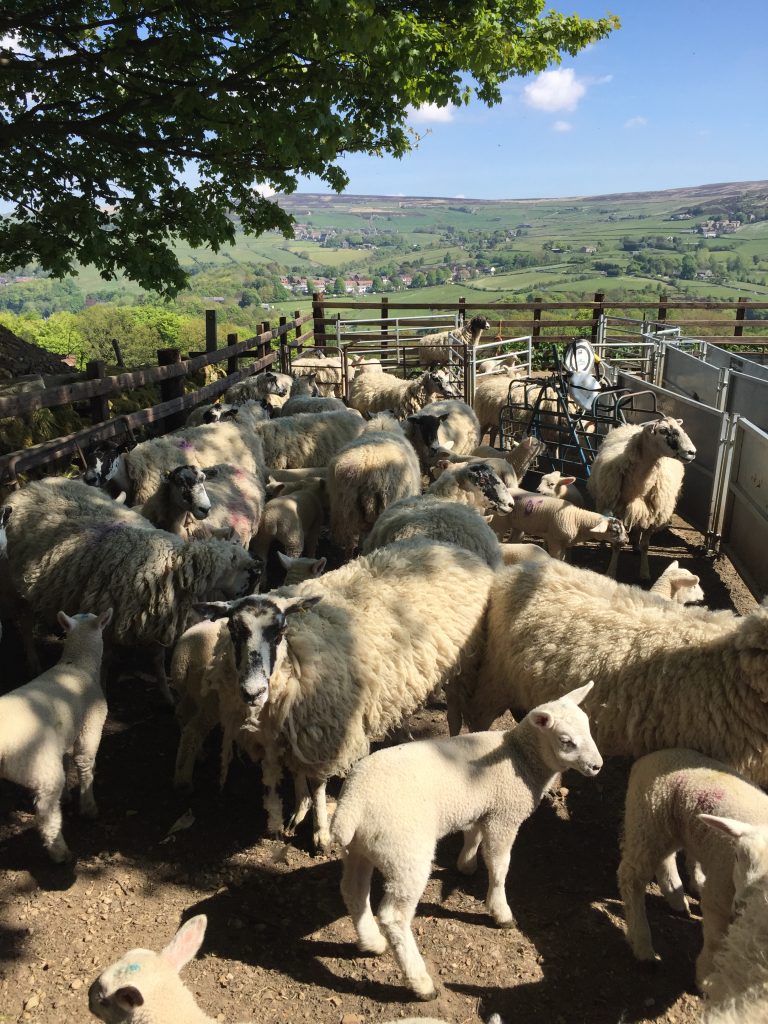
Living just a couple of houses away from William Wilkinson at Old Chamber in 1841 was a slater named John Taylor, his wife Mary and their seven children. At the time there were eighteen households in this tiny hamlet and so everyone must have known each other well.
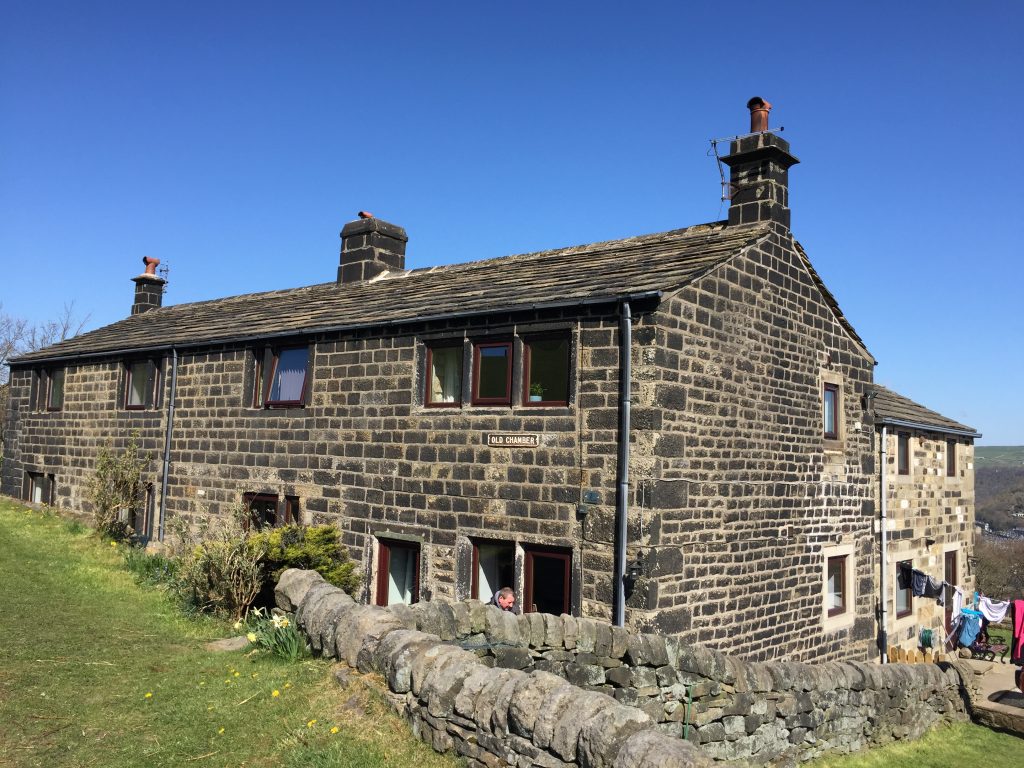
In fact the Wilkinson and the Taylors had two of their children baptized at Heptonstall church on the same day, December 29, 1836 – Rachel Taylor and Sarah Jane Wilkinson. The towers of both the old church and the new church that was built in the early 1850s are visible from Old Chamber today though now they peak out above trees that shroud the packed gravestones, a place that was then bereft of trees. Did the two families share a ride to Heptonstall church in a cart?
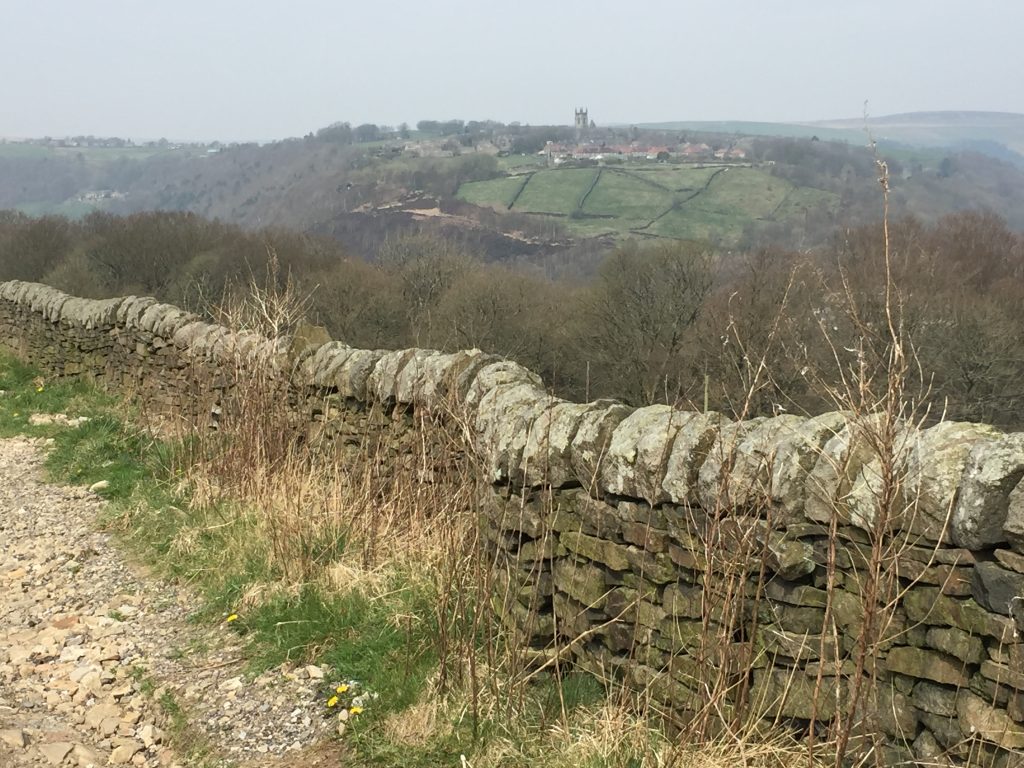
Born in the parish of Warley in 1801, John had been a plasterer by trade when he married Mary Greenwood also of Warley at St John’s Halifax in the summer of 1822. I wonder why they didn’t marry at St Mary’s church in Luddenden which served Warley parish. Mary had been born in the hilltop village of Midgley in 1804. During the following 23 years the couple would have ten children. The older children were baptized at St Mary’s church, Luddenden, so it was in Luddenden that I began my day with the Taylors. It was Easter Sunday, 2021 so armed with a couple of Cadbury’s creme eggs in case I got peckish on my travels I took the ten minute bus ride to Luddenden Foot and then followed the course of Luddenden Brook upstream. After about ten minutes I passed the ancient Kershaw House which I think always looks ill at ease , surrounded on all sides by an interwar and postwar housing development. Kershaw House, now a Grade l listed building predates these more recent homes by a staggering three hundred years and there was a house on the site for two hundred years before that. During the building boom of the 1960s the rambling mansion with its many windows and its unique Tudor rose stained glass window with unusual diamond shaped lights was converted to an inn and though I’d have welcomed a beer there today, as I’ve done before, it is of course currently closed. As I stopped to take a photo of the side of the building I noticed a sign pointing to a building at the rear of the inn’s car park – Little Foot Day nursery.
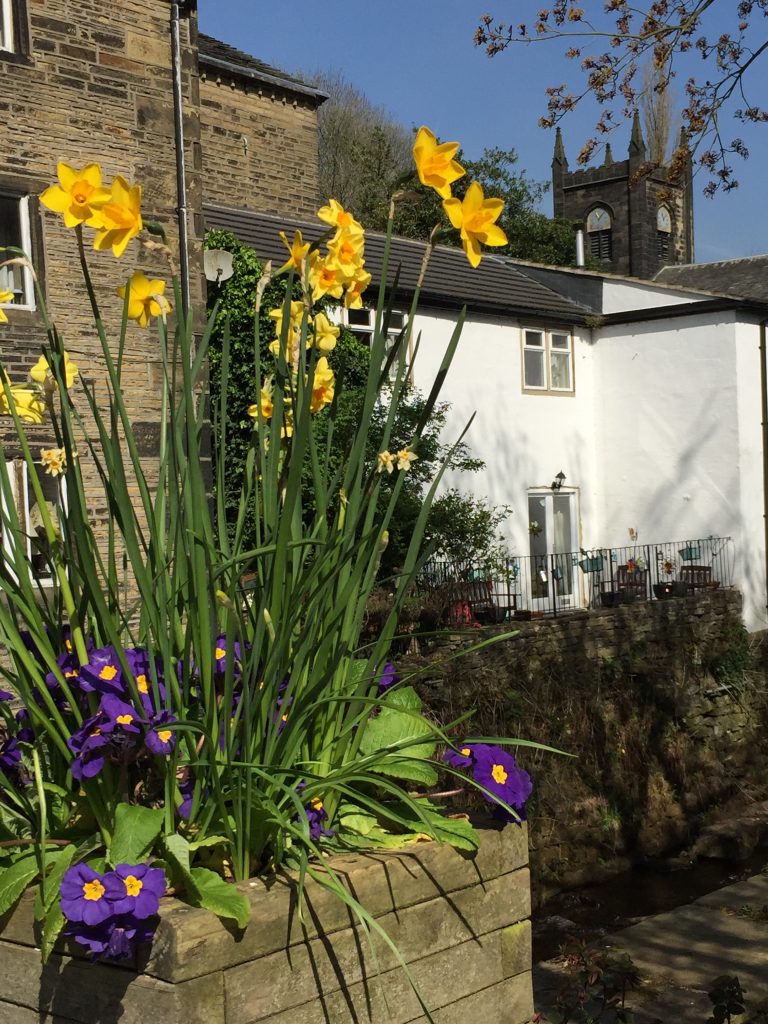
Seeped by the American folklore tales of the ape-like creature that inhabits the forests of North America known as Big Foot I couldn’t help but smile. I followed the river walk, the sides of the valley coming ever closer, and arrived in the heart of the village with its beautiful cottages today bedecked in their finest Spring colours despite the fact Luddenden is so deep in Calderdale that the sun does not find it after October7.[1]
With its old stone houses all huddled together on various levels of the hillsides and its waterfall and sixteenth century bridge in the centre of the village many artists and photographers have made it the subject of their work. Poet laureate Simon Armitage made it the subject of the poem ‘Full moon’ in which he makes up words to rhyme with the strangely named village. Pink blossoms of flowering cherry trees fell gently onto the stone flags on which I walked while tubs of daffodils, narcissus and aubreita radiated their colours in the multitudinous nooks and crannies between the houses bearing testament the village’s gold medal award in Yorkshire in Bloom competition in 2012. These Luddendenites are rightly proud of their beautification of the village.
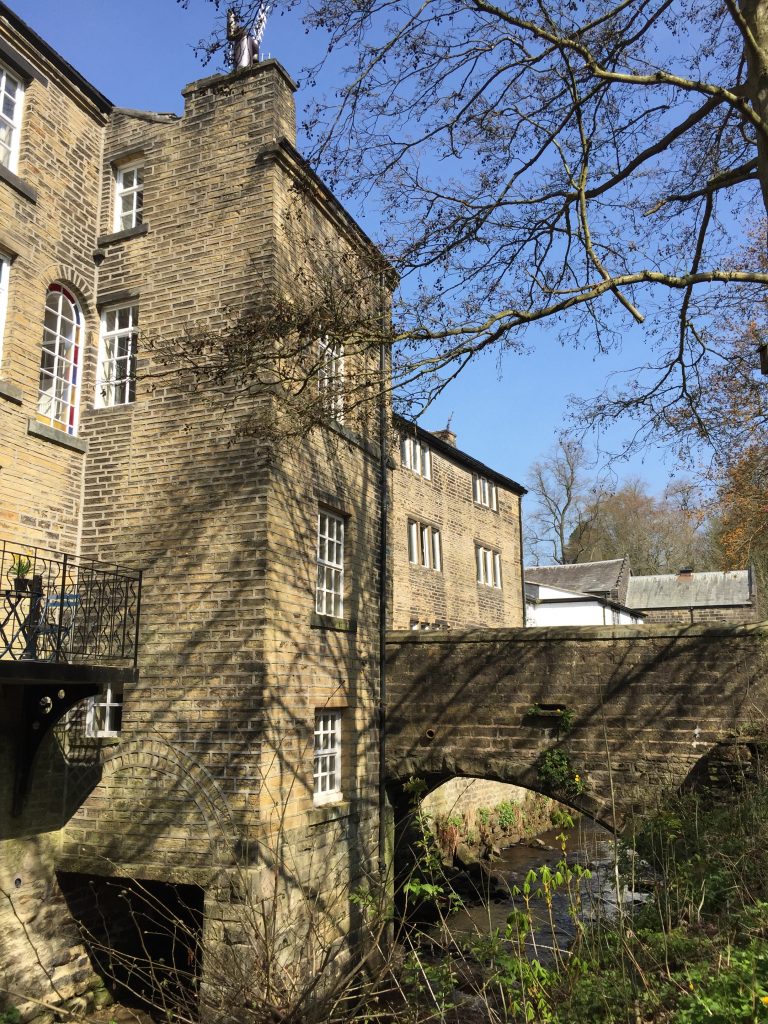
Even the trash bin on the riverside walk is embossed with a date – 1989, alongside a Yorkshire rose. Four hundred years ago Luddenden Valley was one of the richest places in the country, as yeoman clothiers sold textiles all over England and exported to Europe. They built some of the finest houses in the Luddenden area during this time.[2] In fact, there are said to be more houses of 17th and 18th century origin in the Luddenden Valley than any other comparable area in the country.[3] I was fortunate enough to be a guest of the High Sheriff of West Yorkshire at one of these houses, Peel House, for a Christmas eve celebration in 2019. Built in 1598 it is the oldest known house still in use in Luddenden and its interior preserves many of its original features.
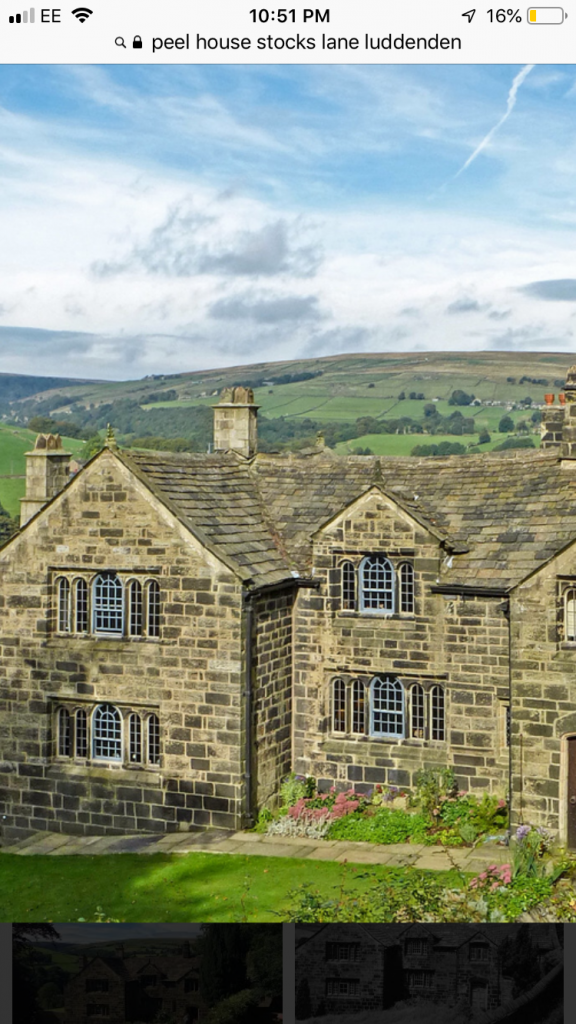
I passed the Lord Nelson pub where a library was in use from 1776-1917. It is particularly of note because of its association with Branwell Bronte, who used to frequent it when working as a booking clerk at Luddendenfoot station, and living at Brearley Hall, another home of my ancestors whose story can be found in another chapter. Four years ago The Lord Nelson had provided much needed sustenance for Sarah and myself following our climb to Stoodley Pike, but of course it is now closed. Following the river, whose roar gives the village its Anglo Saxon name – a clearing in the valley of the loud river – I came to St Mary’s church where some of the Taylor children were baptised. A path around the gothic style church is made up of gravestones dating back to the 1700s and in places stairs have been made, also out of gravestones. Part of the cemetery wall has gravestones propped up against it. Little remains of the original church, built here in 1536 but it was demolished in 1814 and rebuilt, opening in 1817. The only fabric surviving from this building are some window mullions incorporated into the interior nave walls of the present building, and also three human mask corbels set into the West boundary of the churchyard. So when John, son of James Taylor, a plasterer by trade, and his wife Mary was baptised in Luddenden it would have been at the old church but by the time John’s own children were baptised the ceremony would have taken place in the newly erected church. Today I was surprised to see the church door open. Not only that but someone inside greeted me with “Hello, do come in.” Once inside I was handed a palm cross, reminding me that it was in fact Palm Sunday. At Turton church as a child I would be given a palm cross in the service – a tradition I’d completely forgotten about until this moment. I remarked that Luddenden isn’t on the tourist trail in the same way that Heptonstall is, a village of a similar size. “We like it that way,” came the immediate response. I looked for the memorial to Rev. William Grimshaw, buried here in 1763, by the side of his first wife. I keep crossing paths with him in my research. His brother John had been incumbent at Cross Stone church where many of my ancestors were married and buried, before taking up that position at Luddenden.
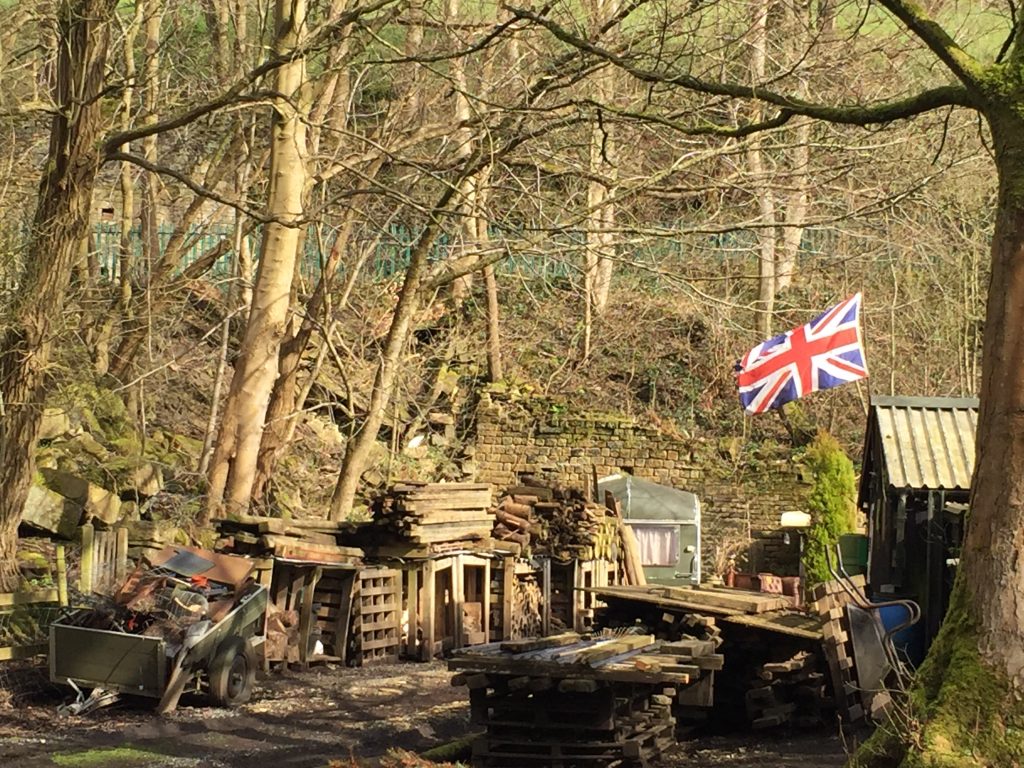
I carried on along the track above Luddenden Brook passing the remains of former mills and long flights of well worn stairs leading from them up the near vertical hillside to the workers’ houses.
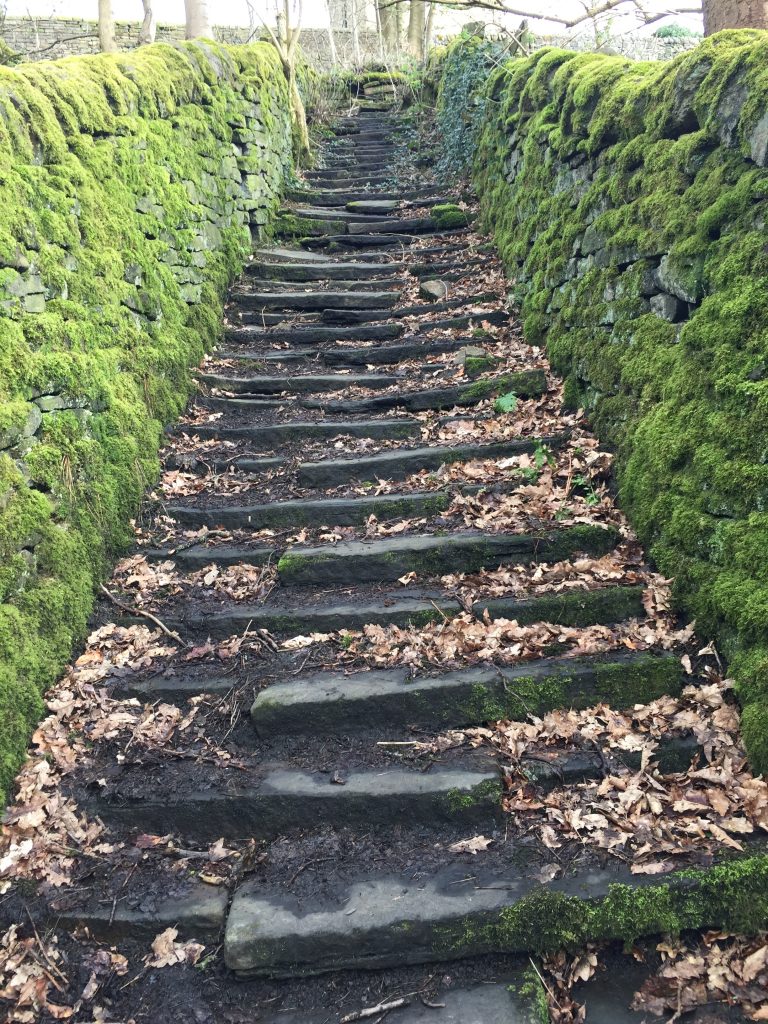
Interspersed between the ruined walls of Peel House mill was an allotment. But this was no ordinary allotment. I could barely believe what I was seeing. A conglomeration of wooden sheds, one of which was invitingly named the Bug Hotel, were surrounded by neatly stacked wood piles which had taken on more the guise of elaborate sculptures than mere repositories for wood. An old caravan was surrounded by soft velvet sofas and a leather arm chair. A terracotta house chimney was set out on the lawn, filled with an attractive display of dried grasses while green wheelbarrows stood proudly against a red shed, newly painted.
Amidst all this chickens pecked and geese strutted, evidently eyeing up this stranger. It reminded me that I was feeling peckish too so I took out a chocolate egg to munched on. At that very moment a man walked up the track towards me but before I could say hello he had turned off and yes, he was opening the gate into the allotment. He invited me in and told me his story. A dry stone waller by profession he’s kept the allotment for twenty years, nurturing its every need. He repaints all the sheds every year and has several fire pits strewn around the property for warmth in winter. When I took my leave of —- and his – – — – my two Cadbury’s eggs had been consumed but had been replaced with half a dozen eggs supplied by the residents of the Bug Hotel.
As I retraced my steps passing St Mary’s I thought of Paul Taylor being baptized there in the depths of winter, on December 20, 1829, Anna’s birthday. By 1832 the family had moved to Old Chamber as seen by the baptism record of Paul’s brother James. By the next census two more children had been born, Greenwood (his mother’s maiden name) and Betty. It appears that John has given up being a slater and is now a farmer of 18 acres and the census specifically states that he has no labourers suggesting that this would be rare. Hannah, is a servant, Paul and John are plasterers, James is a scholar- at 19? Rachel is a factory labourer, Henry is an agricultural labourer, Greenwood and Betty are scholars and visiting them is Mary’s mother, Hannah Greenwood, now 64 and also born in Midgley.
On 2nd April 1854 Paul married Sarah Ann Gibson at St John’s, Halifax, and it’s through her that I am connected to the Taylor family. Her brother Thomas, a butcher, was a witness at their wedding. Sarah Ann is Joshua Gibson’s daughter and had grown up at The Bull Inn where her father was the landlord until he took his own life in 1858. During the next 16 years Paul and Sarah Ann had ten children. At some point, perhaps when they got married, they moved down into the valley and settled in Hebden Bridge for in 1861 they are running a beerhouse on Bridge Lanes just steps away from The Bull Inn. Besides running the pub Paul is also a slater, just like his father. Living with them is Sarah’s brother Richard Gibson, a machinist and millwright, who, like his father, would take his own life, as would his wife Rose causing the newspaper to headline the column ‘Is suicide hereditary? ‘ [4] In the 1871 census Paul is listed as both a beershop keeper and slater – reflecting his previous and current businesses. Their son John, 16, is a cotton weaver and daughter Sarah, now 14, is a sewing machinist. This is highly significant because she would marry Richard Redman because she played a pivotal role in the establishment of Redman empire, a highly successful international sewing company whose story is told in another chapter. Richard, 12, mule piecer as is his brother Willie, aged 9!
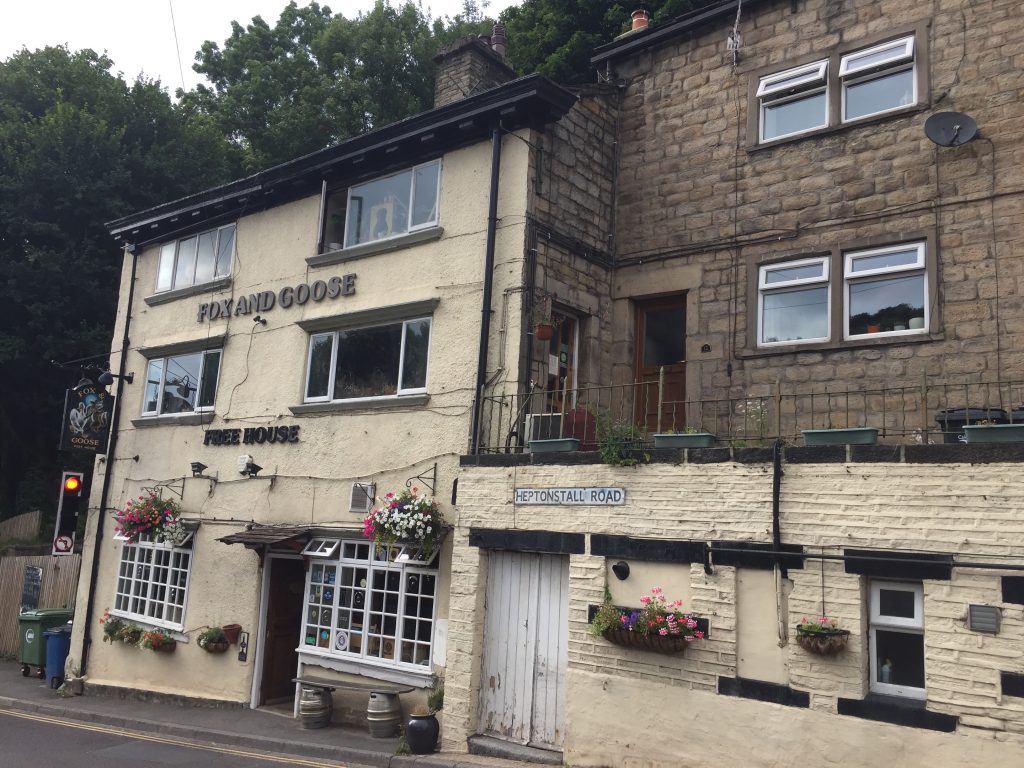
But which pub were Paul and Sarah Ann keeping? The tightly packed community known as Bridge Lanes was a conglomeration of streets connected by stone steps on the West end of the town centre, demolished in the 1960s and there is little left of details of the area. However, the earliest reference to a named pub that the Taylors ran was in 1875 when they were keeping The Fox and Goose. Oh my. When the floods of February 2020 in Hebden prevented me from accessing my home after playing the organ for the service at Heptonstall church I sought refuge in The Fox and Goose, primarily because its location is slightly elevated from the centre of town and was therefore above water! Along with other refuge seekers, some visiting the town on holiday, I was provided with warm food and as much tea as I could cope with. I was so grateful. What a surprise to find that my ancestors had been the landlord here 145 years before. I hope they were as kind and inviting to their customers as today’s landlord is. I later found a reference in a local paper that the Taylors had been running the Fox and Goose for 42 years when the article was written in 1899, placing the Taylor family as residents there from 1857. [5]
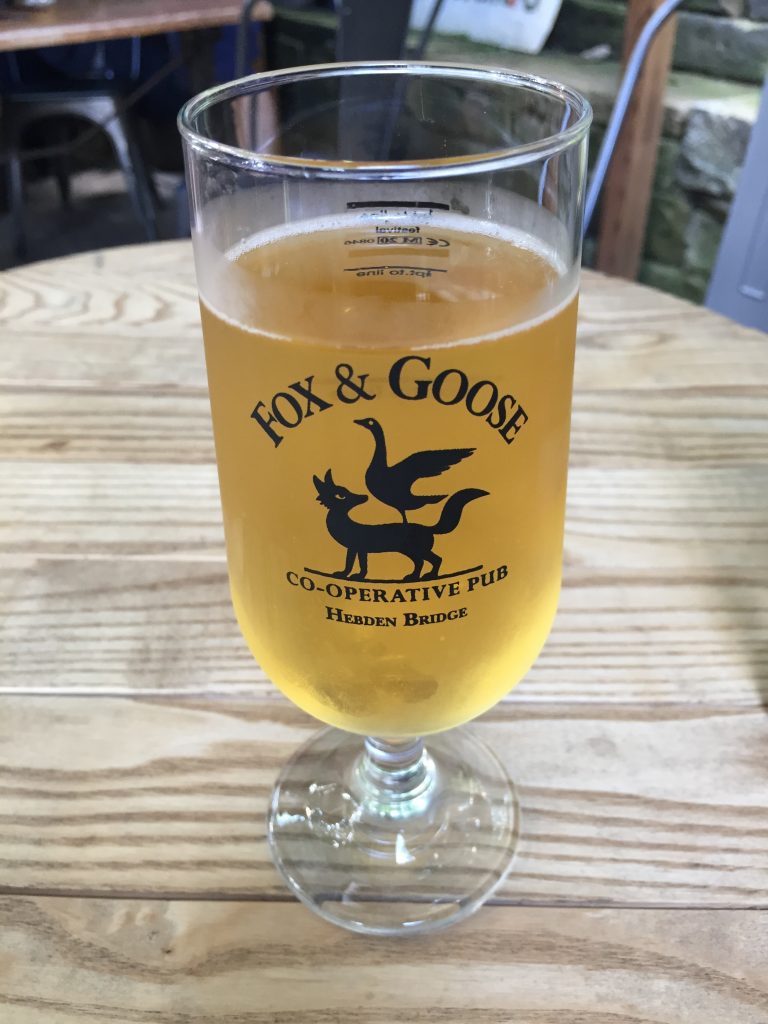
I retraced my steps along Luddenden Brook and jumped on a bus heading back into Hebden Bridge, alighting at the turning circle at the bottom of Heptonstall Road. Now that I knew of my family connection to the Fox and Goose I was eager to pay that hostelry another visit. West Yorkshire’s first community owned pub and Calderdale’s pub of the year in 2019 has a couple of benches outside the front door and a man who I took to be connected with the business was sitting, enjoying the afternoon sunshine. I explained my mission and asked if he knew anything about the history of the building or its former landlords. “Well, it was built as an inn in the early 1300s according to the documents held in Wakefield but I don’t know much else until the 60’s” “The 1360s?’ I inquired. “No, the 1960s.” He invited me to forward anything I found out about the pub’s history to him.
As I took my leave he looked forward to welcoming me into the pub when it reopens. As I thanked him I recalled an incident when landlord Paul may have ben a little too welcoming.
In 1875 Paul was charged with permitting drunkenness on his premises between 10 and 11 pm. When two bobbies entered the premises they found Paul Taylor in the taproom, along with James Clayton, the blacksmith, with a mug of beer in front of him and ‘another man in who was fresh.’ Paul was fined 20s. In the same year it appears that the same two bobbies were again on Paul’s trail. This time Paul and another man were spotted by the two plain clothed bobbies playing cards ‘on the Lord’s day’ at Rawtenstall wood, the very steep hill that rises directly above the pub, – and gambling. Greenwood was captured on the spot but Taylor ran off but took his cap off and looked back. One bobby said “That’s Paul Taylor, the landlord.” Greenwood was taken to the lock up. Taylor denied being there and called others as witnesses who supported his claim and his case was adjourned. I’ll never be able to wander around that wood just above Bridge Lanes again without looking out for those plain clothed bobbies!
While this incident had a comedic element to it in today’s world five years later tragedy befell Paul and his wife when their six year old son, Frank, drowned on his way home from school, St James’s, Mytholm. It was the depths of winter, February 1880. Frank was dismissed from school at 4:10. It would have been totally dark by that time but there was a lit gaslight close by. Frank clambered over the wall opposite the school and climbed down to the river where the school children were known to like to slide on the frozen dam. Below the dam, was the ‘panhole’ – a hole four feet deep, with no fencing around it, just below a small waterfall. Frank balanced on some ice on the frozen Colden Beck and reached into the panhole to gather some ice. Someone on the bridge saw him fall into the panhole and Richard Mellor, the schoolmaster was summoned and was quickly on the scene. Mellor could just see the top of Frank’s head peeking above the hole. He managed to retrieve Frank but his attempts to resuscitate him failed.
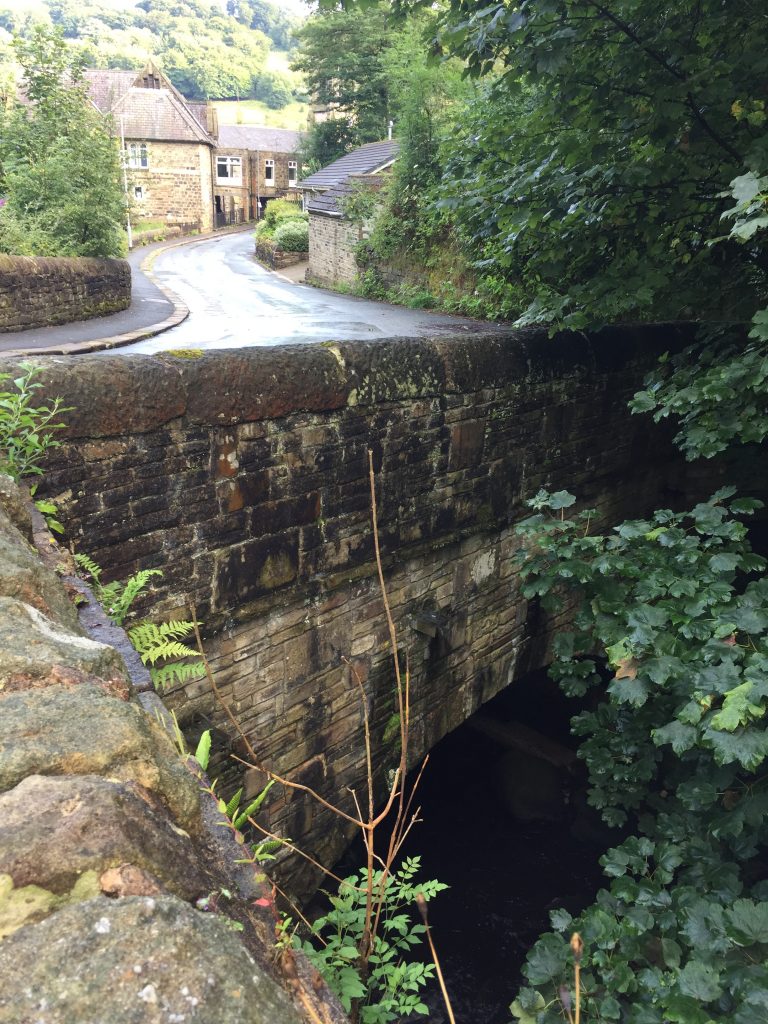
Was this the bridge from where someone saw Frank fall into the Colden Beck? 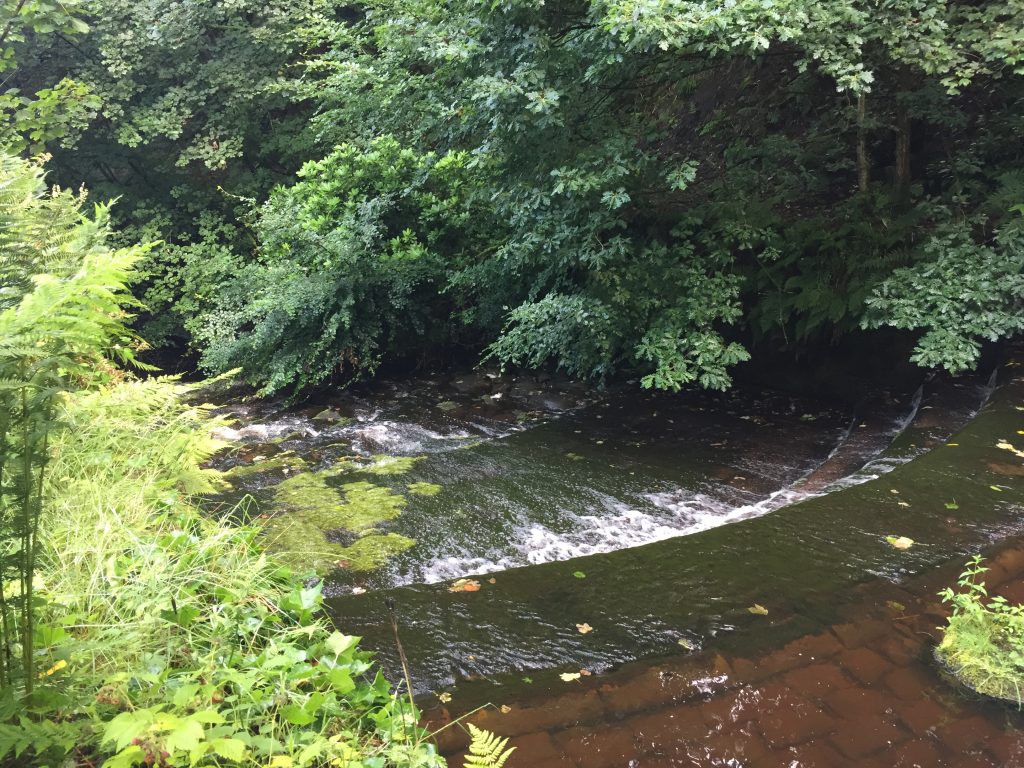
Colden Beck from the bridge 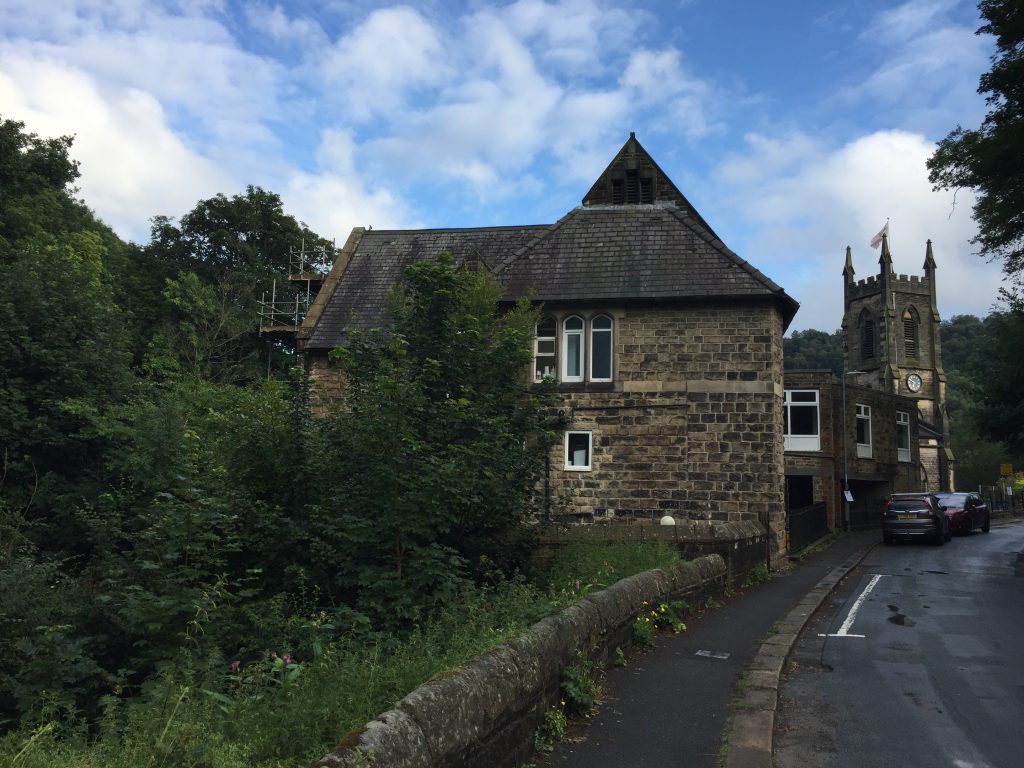
frank’s school and St James’s church
Frank’s body was taken to his home at the Fox and Goose, just five minutes walk from the school. His dad was out feeding the pigs at the time but within minutes a doctor was called for, but his efforts too were in vain. The shock for his parents and five siblings is unfathomable. They had already lost one son, Gibson, who had died a few months short of his second birthday. At the inquest into Frank’s death held at the Bull Inn, Frank’s mother’s former home, in giving evidence the schoolmaster commented that “If P.C. Eastwood would visit the school and give a warning to the scholars it would no doubt frighten them for a time.” The school lies just a few hundred yards up Church Lane and I crossed over the Colden River on Bankfoot bridge where, in the Taylor family’s day stood Bankfoot Mill, spinning and weaving. St James’s church where I sometimes play the organ for services was to my right and directly behind it is the school that Frank attended. The school was established in 1870 and funded by public subscription- …”a school shall be established for the education of children and adults or children only of the labouring, manufacturing, and other poorer crafts of the ecclesiastical district of Hebden Bridge…”[6] Originally it was a single storey building and all the children were taught together. However, in 1880, the year of the tragedy, it was decided to separate the ‘Mixed’ from the ‘Infants’ with Richard Mellor head of the mixed and Mrs Mellor head of the infants. In 1888 a second storey was added for the needs of the growing population and I’m proud to say that my Wrigley ancestors were employed to carry out the painting. So from the Fox and Goose I headed to St James’s school and the scene of Frank’s death. Passing the former site of Bankfoot Mill, a spinning and weaving mill that would have been a hive of activity at the time but which was demolished in 1971. Mytholm school lies directly behind St James’s church, The site for both had been donated by James Armitage Rhodes of Mytholm Hall. He had reserved a piece of triangular land behind the church. “I reserved it for a School: but I subsequently thought that it was too dark – as light is essential to the well conducting a School.”[7] A low stone wall, barely two feet surrounds the perimeter of the school and directly below the ground drops vertically to the river. I could make out a weir, which is probably ‘the waterfall’ referred to in the inquest into Frank’s death as I stood on the bridge, probably standing in the very spot from where the schoolmaster could see Frank’s head peeking above the hole.
By the time of the 1881 census Paul’s children Richard, John and Sarah had all married and set up homes close by. The most interesting of these marriage from my family history’s perspective is that of Sarah who had married Richard Redman in the summer previous to Frank’s death. This means that Sarah is connected to me twice over! Sarah was a sewing machinist, as were her sisters Annie and Mary, and her pivotal role in the development of her husband’s clothing manufacturing business, which developed into an international concern is the subject of another chapter. But I was to come across the name of the school master who had tried to save Frank’s life again in my research, finding that I am, in fact, a distant relative. Paul’s daughter, Mary married the school master’s son, Thomas Cooper Mellor in 1892 at, where else, but St James’s church. Their marriage certificate bears their two signatures but it also includes the signature of Richard Mellors, a witness to their marriage and school teacher to Paul’s children.
Meanwhile back at the ranch Paul was having problems with the privy. Back in 1878 Paul had been required to undertake the drainage and completion of closets to his houses at newgate end as per plans submitted to the board. But four years later it was reported in the Todmorden Advertiser that ‘ there is a continual nuisance in and about the privy belonging to Paul Taylor, Newgate end which is caused by the defective drains of the 2 cottages belonging to Thomas Sutcliffe.’ Eight years later Paul and his sanitary conditions was still making the newspaper columns when
1890 building and nuisance committee abate a nuisance arising from a defective urinal. But ten years later Paul’s connection with another story in the paper is no laughing matter. By this time their daughter Ellen is 35 and living at home, as are her sister Mary, a fustian tailoress and brother James, a clerk for a courier. Ellen had no occupation listed on the census of 1891 which is very unusual. She ‘helped around the house’ we are told by her father. Following a serious bout of influenza she had been afflicted with much pain in her head and back and had been attended to by the local doctor. Shortly after her brother Richard and his wife went away on holiday to Blackpool for a few days and had given their house key to Ellen so that she could look after the cat, the dog and the bird while they were away. During this period Ellen had left the Fox and Goose but didn’t return that night. Her parents were not anxious. They thought that she’d gone up to Heptonstall to help her sister look after a boy who was ill for Annie was now keeping the White Lion in Heptonstall with her husband, John Butterworth. When Richard returned from his holiday he called in at the Fox and Goose to get his key back from Ellen but found that she hadn’t been home the previous night. When the family checked with her sister and found that she hadn’t been to the White Lion they went to Richard’s house, broke down the door, it being barred on the inside. Laid out on the bed, fully clothed was Ellen, a handkerchief tied around her head is if to reduce the pain there. The door crevices had been filled with brown paper and her petticoat had been stuffed at the bottom of the door. The gas tap was open at full. “I should say she had been driven crazy with pain,” stated Mr Clay at the inquest and a verdict was returned – that she had suffocated herself with coal gas while in an unsound state of mind.” Perhaps the first thing that came to mind when I read this was the suicide of Sylvia Plath, wife of the poet laureate Ted Hughes whose demise has been recounted in detail in several films and biographies. A much less detailed account was the attempted suicide of my grandmother’s second husband, Harry Hall, just days after their marriage. He survived and lived for four more years dying of natural causes – in the county mental hospital.
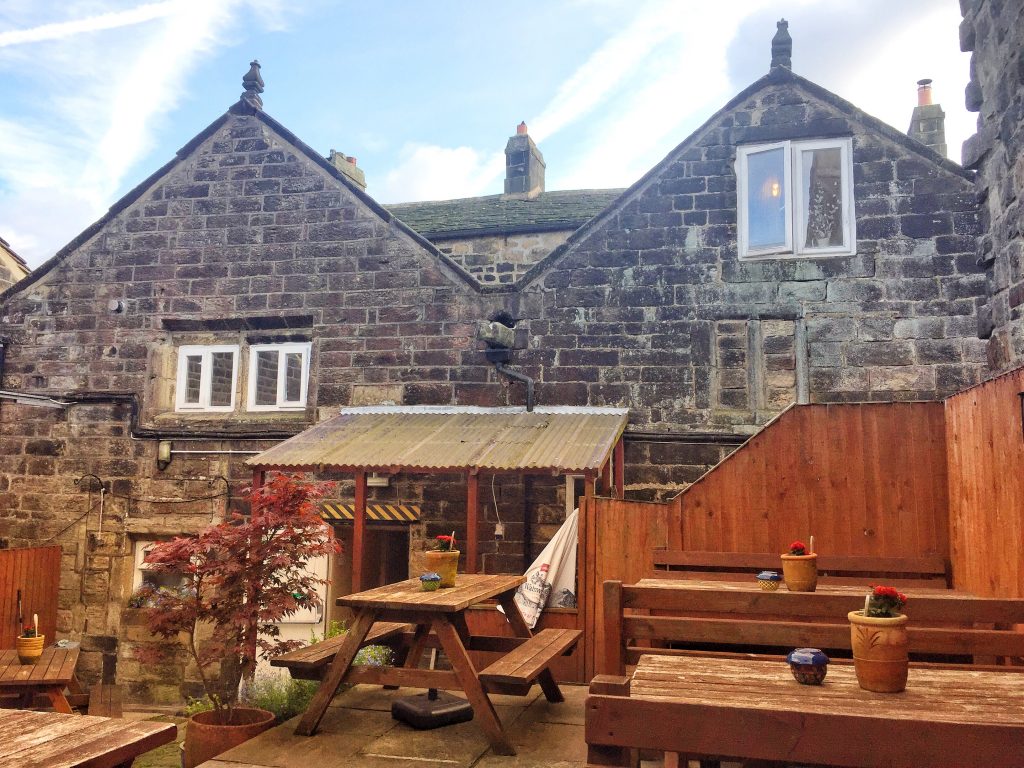
Nine months after Ellen’s death a temporary transfer of the beer license took place between John Butterworth, Annie’s husband, at the White Lion and Paul Taylor of the Fox and Goose. So Paul and Sarah Ann move up to run the White Lion and two months later Paul’s next appearance in the newspaper is something very close to my own heart. At Todmorden petty sessions Paul applies for an extension of the inn’s opening hours for a very special occasion: the Heptonstall Brass band contest. He is granted ‘an occasional license’ which allowed him to open the pub from 2-8p.m. on that one Saturday for the event. 14 brass bands entered from as far away as Derbyshire but two didn’t show up. The contest, lasting 4 hours, at which it was noted that ‘at least one female watched the contest for the whole 4 hours.’ [8] took place on a grassy field close to the school and ‘the weather was beautiful and the green pasture land for miles around afforded an admirable spectacle for visitors. ‘ [9]’At the end of the performances the crowd gathered around the enclosure to await the decision of the judge. When the first prize was awarded to Rochdale public band the decision was ‘received with uproarious shouting.’ After the contest a gala was held when, according to the rules, the winning band played until dusk. Unfortunately Rochdale public band had failed to bring any other music apart from the contest music with them. I wondered if they thought they had no chance of winning, or whether it was merely an oversight. However, Heptonstall band, who had not participated in the contest, came to the rescue and provided music and the dancers were kept alive til 8 o’clock. The District News then reprints the judge’s remarks for all the bands in their entirety. As I read phrases such as ‘in the Cantabile section the trombone should try to kill that nervousness’ and ‘euphonium did not play bar 4 correct’ ‘crescendo in bar 9 too abrupt,’ ‘accompaniment not in sympathy with the melody,’ and ‘accompaniments not dead in tune: a little wolfy,’ I laughed out loud. Nothing has changed in 120 years! My experience as both a classical music critic for newspaper and magazines, an evaluator for piano exams and my time playing and composing works for concert band makes me relish these descriptions.
With my headphones I listened again to a CD of band music recorded in 2018 by Halifax Concert band on which I was a participant I girded my loins for the steep climb to Heptonstall. Passing the overgrown wasteland that once was home to the thriving community of Bridge Lanes and then passing Lily Hall, the genesis of my story, I arrived at the cobbled street in the centre of Heptonstall. To my left the tower of the church where . . . . and passing The Cross pub on my right I arrived at The White Lion, the inn operated by Paul’s son-in-law John Butterworth, and then for a brief time by Paul himself during the band contect. As I sat on the picnic table outside the pub, the penultimate piece on the CD, settled themselves in my ears: ‘Once Upon a Time in America,’ by Ennio Morricone.
I retraced my steps down Heptonstall Road where the last building on the right is the Fox and Goose where three years after the excitement of the brass band contest Paul was fined 5s for being drunk in charge of a horse and cart. Once the Butterworths had taken over its running Paul and Sarah Ann lived out the rest of their lives at 3 Heptonstall Road. I have an inkling that it may have been on the site that is now the pub’s beer garden, elevated high above the road, from where an overgrown track leads through Rawtenstall Woods.
Paul died in 1904 and Sarah Ann, seven years later, living at 3 Heptonstall Road. Finding 3 Heptonstall Road was more tricky than I anticipated, but there were clues. The pub is now numbered #7 Heptonstall Road yet it’s the first building on the street. I returned to the pub several months later when the pandemic restrictions had been lifted. It’s a lovely old world pub exuding a feeling of community with its area divided into small rooms with quaint signs indicating their names. The small room next to the toilets is ‘The Waiting Room.’ Historical photographs line the uneven stone walls , interspersed with historic beer mats and framed certificates for Best pub of the Year. A photo of the inn dated 1960s showed rubble adjoining the left side of the pub on the almost vertical hillside and to its left the end of what appeared to be a terrace of houses, taller than the pub. To the left of the pub today is the elevated beer garden, access being gained from a flight of very step stairs within the pub. Below the beer garden a fenced area hides a small yard where the rubbish bins are stored. In another room an older photo shows just the glimpse of a four storey building that was once attached to the pub. Outside in the front street hangs a line of washing. The photo is titled ‘Fox and Goose 1905 when Whittakers “cock o’ the north” brewery from Halifax took over the pub.
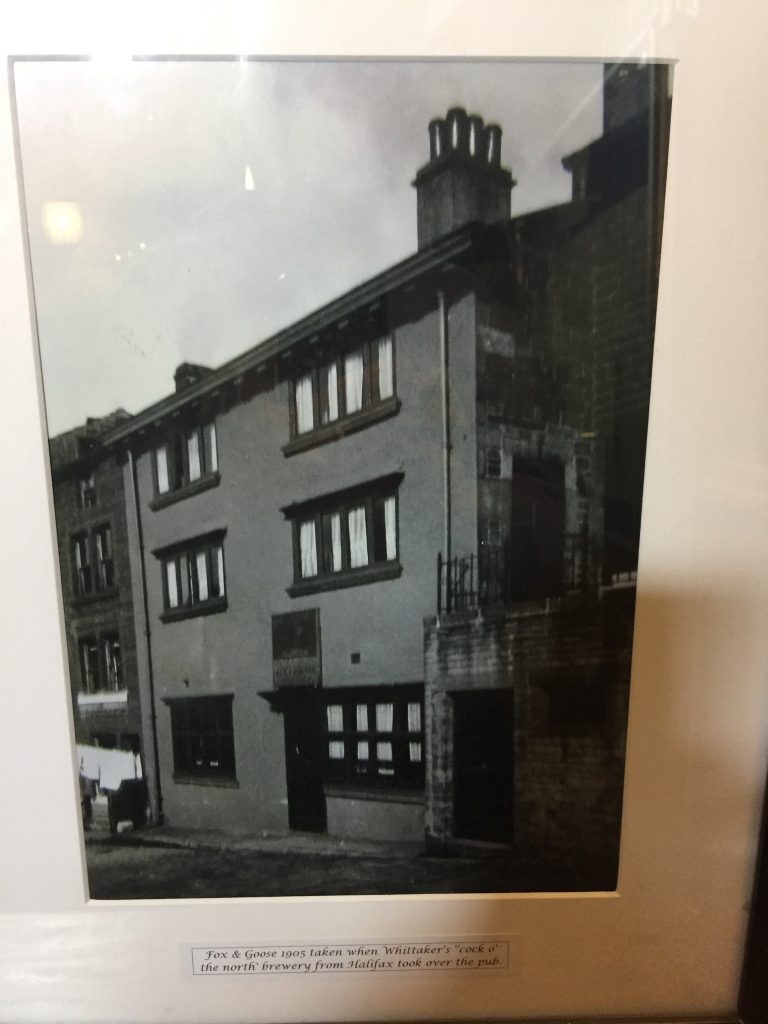
Paul Taylor had died the previous year while living at 3 Heptonstall Road, the running of the pub having been transferred to his son-in-law John Butterworth. Sarah Ann remained at #3 until her death in September, 1911, so the washing outside the house was hers! I headed up the steep stairs carefully balancing my glass of cider and found a seat in the beer garden, now sporting a rainproof roof, a sign of the changing times. I was sitting in the very spot that housed Sarah Ann and Paul in their retirement, imbibing a cool drink from the pub that they’d operated for over forty years.
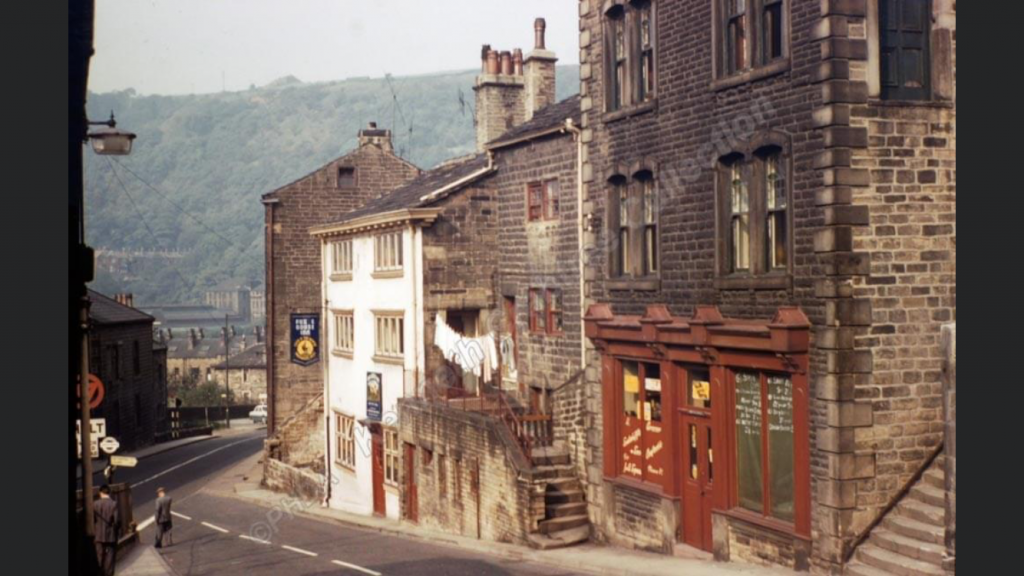
I completed my day with the Taylors in the cemetery where Paul and Sarah Ann are buried along with Paul’s parents John and Mary who remained living at Old Chamber until their deaths in 1879 and 1883. Also buried in the same plot are Mary’s parents, Paul and Hannah Greenwood of Old Chamber.
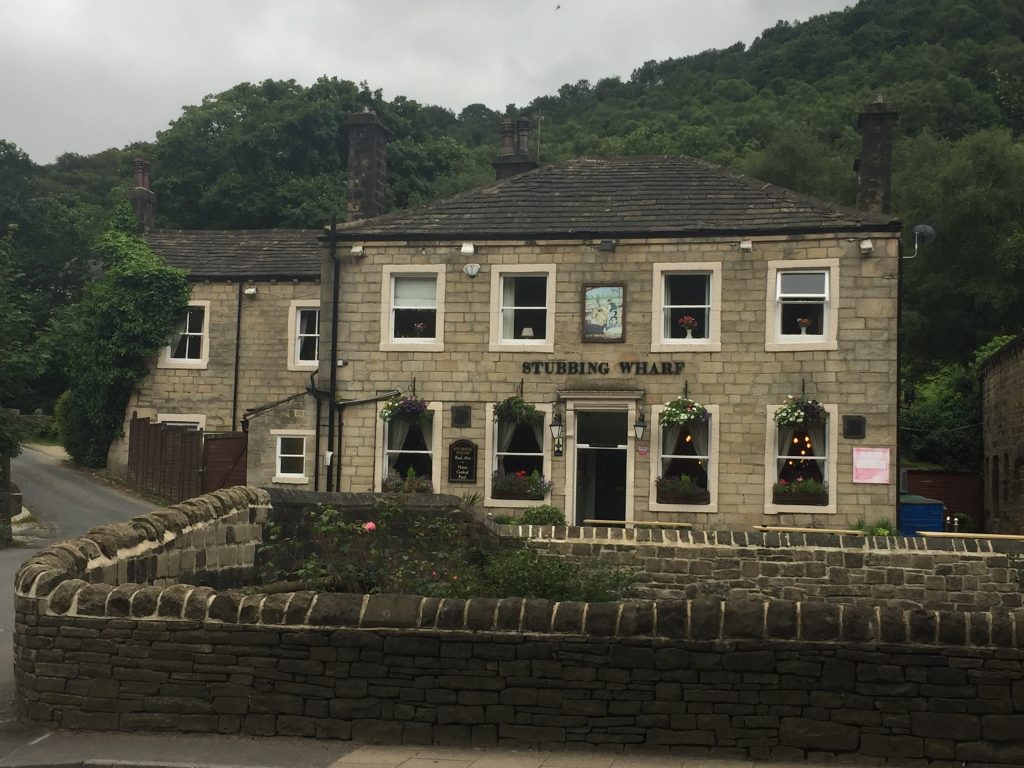
In January 1876 the following notice was issued in the Todmorden Advertiser regarding Paul’s brother, John: “John Taylor of Stubbin Wharf beerhouse, King-street, Hebden Bridge, for being drunk in his own house on the 1st instant, fined 10s, costs 9s.– P.S. Eastwood said a valuation was being taken of the stock ; defendant meant to give up the house.” Paul’s brother, Henry, was landlord of Stubbing Wharf from 1877 and he died there on May 20th, 1892. Like his brother he was buried at St James’s Church in Hebden Bridge. Just two weeks later the license was transferred to his widow, Betty, nee Normanton. How strange to realise that soon after moving to Hebden Bridge Stubbing Wharf pub became the place I would take visitors to with its gentle walk along the canal from the town centre. I even attended a birthday party there in honour of Ted Hughes who wrote a poem about the pub.
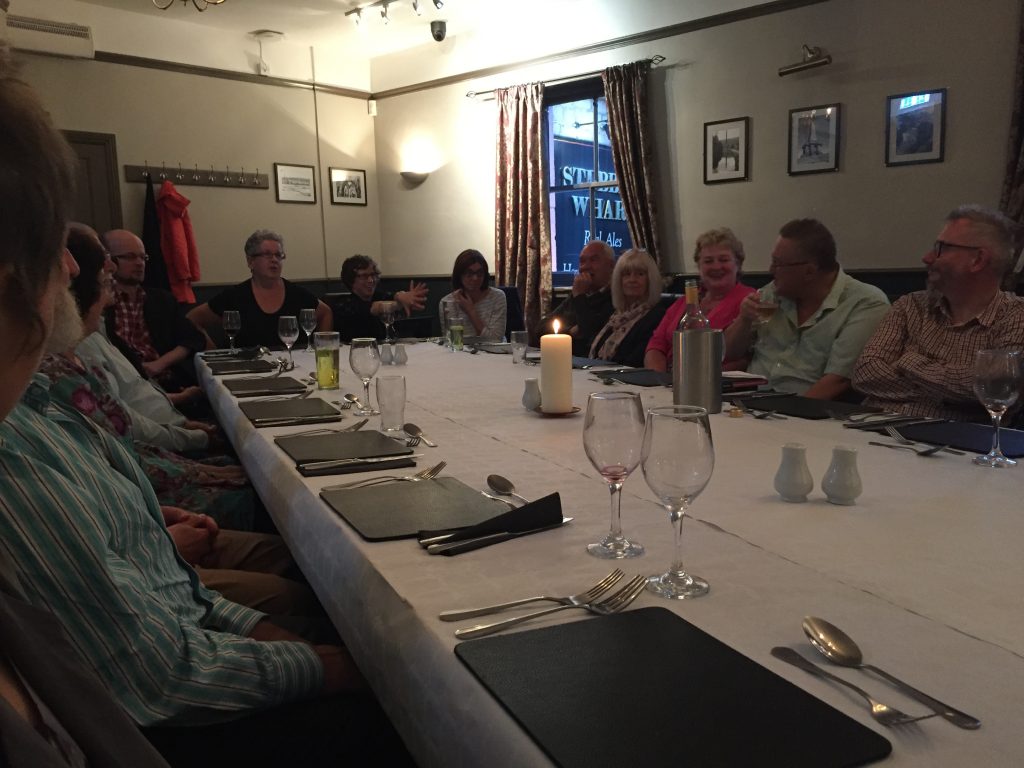
Last time my daughters visited me we enjoyed an evening in the pub looking at old family photos little knowing of our family’s connection with the place!
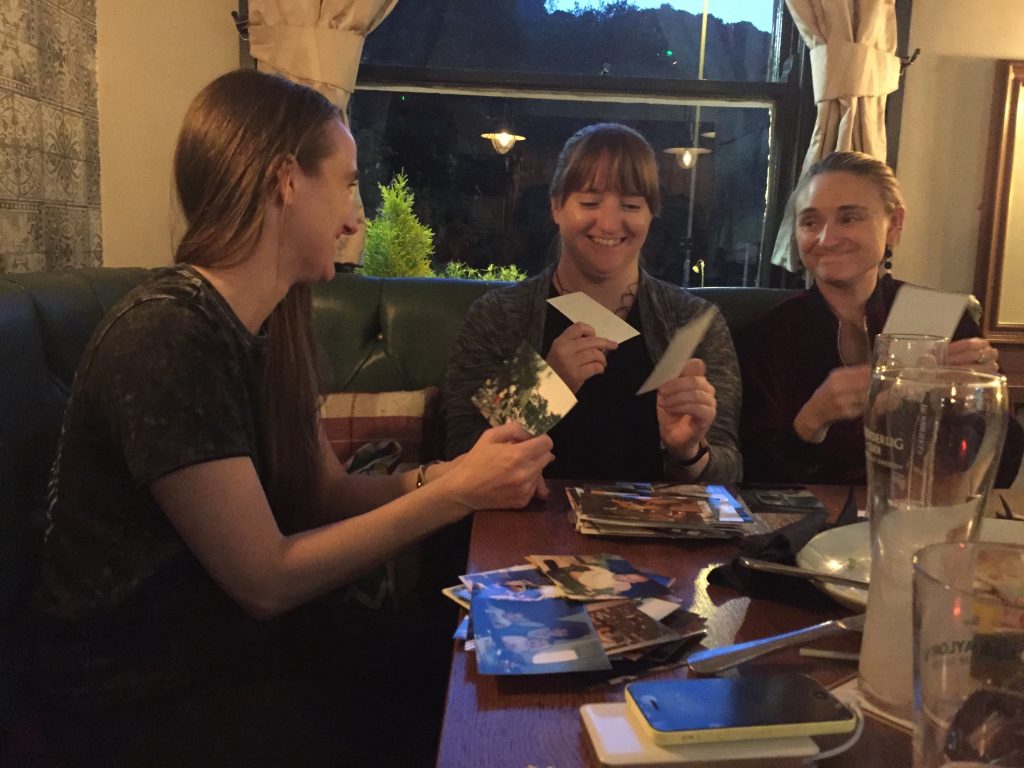
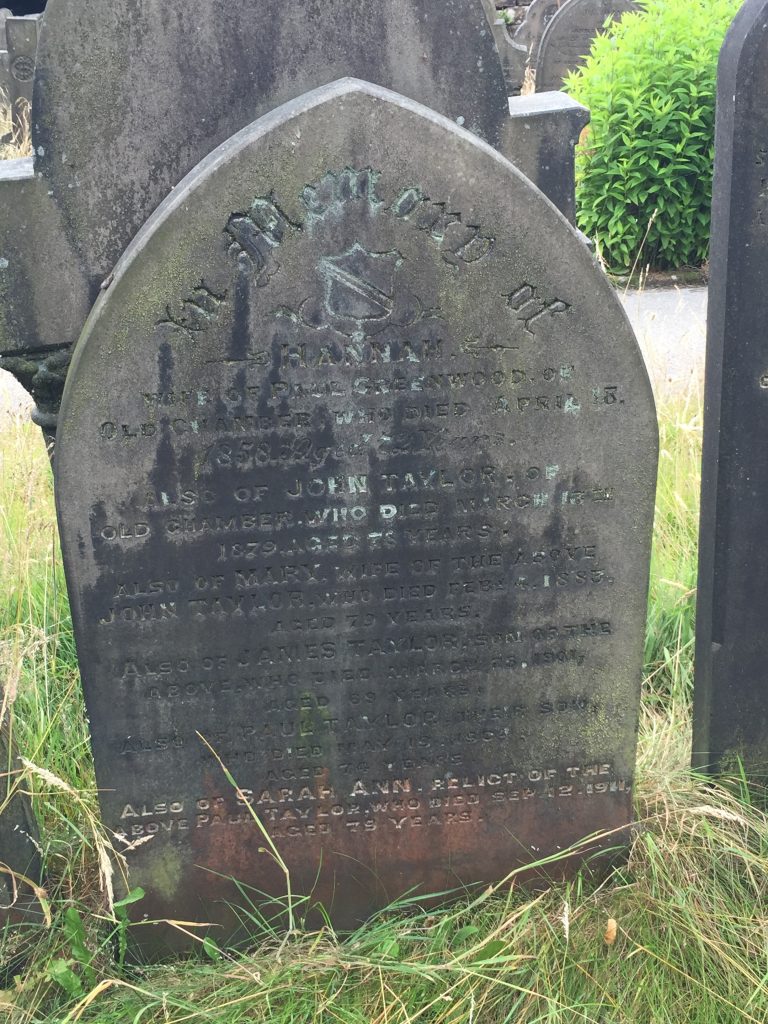
[1] Lilian Robinson (ed.), The Court Rolls of the Manor of Wakefield from October 1651
to September 1652 (1990) quoted: http://midgleywebpages.com/midgleywest.html#settlements
[2] https://www.calderdale.gov.uk/v2/sites/default/files/luddenden-appraisal.pdf
[3] https://www.calderdale.gov.uk/v2/sites/default/files/luddenden-appraisal.pdf
[4] https://www.britishnewspaperarchive.co.uk/viewer/BL/0001940/19100729/050/0003?browse=False
[5] https://www.britishnewspaperarchive.co.uk/viewer/BL/0001940/18990811/084/0005?browse=False
[6] http://www.hebdenbridgehistory.org.uk/charlestown/mytholm.html#school
[7] http://www.hebdenbridgehistory.org.uk/charlestown/mytholm.html#school
[8] https://www.britishnewspaperarchive.co.uk/viewer/bl/0001940/19000601/077/0003
[9] https://www.britishnewspaperarchive.co.uk/viewer/bl/0002124/19000601/066/0007



Recent Comments